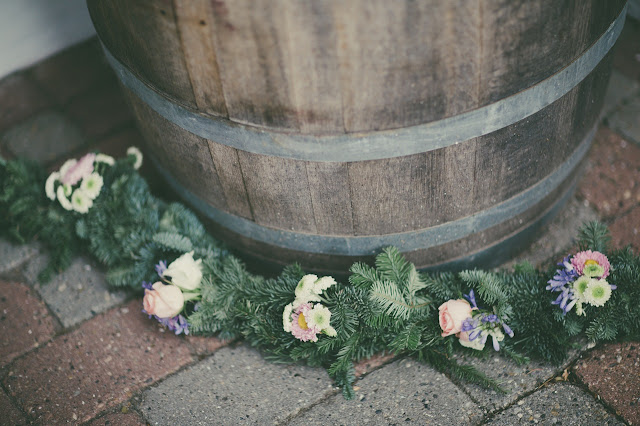Bourbon barrels are made from white oak (Quercia Alba) popularly known as American oak. The cellular structure of this oak contains bubble-like structure, i.e. Tyloses that bulge into the xylem cavities and block the movement of water.

These Tyloses create the oak wood watertight seal which is perfect for mechanized barrel making even with thinner staves.
Tyloses usually help prevent fluid loss and also help make the wood resistant to leakage and rot with prolonged contact with bourbon. What’s more important is, how the small amounts of oxygen can play their role in the maturation of distillate.
Bourbon flows in and out of the wood due to the temperature changes with the season. It shows the deepest penetration into the forest.
Oakwood has a much tighter cell structure allowing the barrel to hold up over the time without any leakage and allow a gentler and slower interaction between the wood and the bourbon.
The concept is using oak trees to produce barrels is easily 100-200 years old. During the formation of bourbon barrels, the oak wood is dried thoroughly to make it ready for long term storage of liquid and to ease the construction process as well. Every cooperage does this in his unique way, but most of them dry the source wood naturally for an extended period.

Charring and toasting are also performed differently according to the distillery preferences but when it comes to bourbon; the bourbon barrels must be at least somewhat charred.
Toasting means gentle heating that cause less caramelisation, and it is less common than charring. The charring refers to the burning of wood until the black producing more profound effect on the structure of wood appears.
These heating processes make the chemical reactions to take place in the forest which are necessary to develop the flavor compounds which will be imparted to the bourbon inside the barrel.
The charring of barrel also creates a layer which helps filter out the sulphur and other compounds that may create off flavors in the wood over time.
Many people may have the question in their mind that where does the barrel flavors come from.
Flavors found in bourbon are due to a complex interaction of the barrel, the storage conditions, storage environment, distilling process and the grains used.
Oak cell wall contains lignins which are composed of various aldehydes, acids, and sugars that can also be broken down during the heating. These constantly degrade during the maturation due to the interactions with the alcohol in the bourbon. The most notable flavors of these products are vanillin acid and vanillin.
The key factors which matter most in the production of bourbon are fresh American oak barrels, charring, toasting of barrels and mash bill. The barrelling strength of the bourbon is essential for the successful whiskey. Alcohol is much better flavor carrier and solvent than water.
The higher the barrelling strength of the bourbon in the cask, the less flavor of charring and toasting is left in the barrels for the later whiskey. The raw whiskey is colorless it gets a golden color after the bourbon is being dumped from the barrel.
The entire color of whiskey comes from the barrel. Some examples of whiskeys matured in used barrels of bourbon are now more scotch whiskey (purely aged in bourbon barrel), tullibardine sovereign (aged in first bourbon barrels).
The production of bourbon whiskey involves the following steps:
- Grain selection and mixture
- Water Addition
- Grain cooker
- Yeast management
- Fermentation
- Distillation
- Sour mash
- Animal feed
- Filling of barrels
- Storage
- Bottling
Important and less known concepts that consumers should know about bourbon and bourbon barrels:
- Bourbon originated in Kentucky.
- Originally the bourbon comes from the United States of America. The bourbon whiskey used to come from the Bourbon County situated in the Commonwealth of Kentucky. Now bourbon can be made anywhere in the United States.
- The bluegrass state is the only place that has the perfect natural mix of conditions, climate and pure limestone water required to produce the most magnificent bourbon in the world.
- America's only native spirit is bourbon. It must be made with at least 51% corn, matured in new charred oak barrels.
- Kentucky tourism is revolutionized by bourbon, and it poured much-needed revenue into the local communities.
- Most bourbon distilleries do not make an age claim.
- Some scotch may have some amount of bourbon in it. Many scotch companies age their spirits in used barrels or bourbon barrels.
- Bourbon should be aged at no more than 125 proof and bottled at 80 to 160 proof.
- Bourbon must have sat for at least 2 years and should not have any added synthetic colors or flavors.
- Once the barrels have been used to mature bourbon, they cannot be used to age bourbon again.
- Bourbon is also known as true spirit due to the strict regulations of the US government for bourbon distillers.
- Used barrels after aging bourbon are mostly sent to scotch and whiskey distilleries particularly in Japan and Europe.
- Some rum and tequila makers also reuse the old bourbon barrels.
- Younger generations are drinking bourbon in cocktails, which shows that the bourbon demographics have changed.
- All bourbon is whiskey, but all whiskey is not bourbon. Whiskey is a specific kind of alcohol distilled from grains. Bourbon is also a particular type of ethanol derived from grains but at very different conditions and climate involving different procedure.
- Kentucky bourbon is the best-known bourbon in the world because Kentucky climate is perfect for aging whiskey.
- As per the law, nothing should be added to bourbon in the process of distillation except water.
- There are more barrels of bourbon than people in Kentucky.
- As per the law bourbon should be aged in a brand-new charred oak barrel.
Comments
Post a Comment